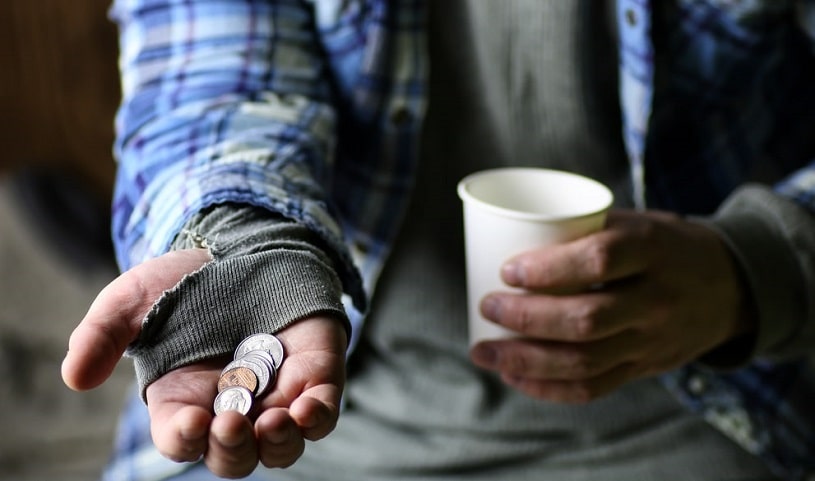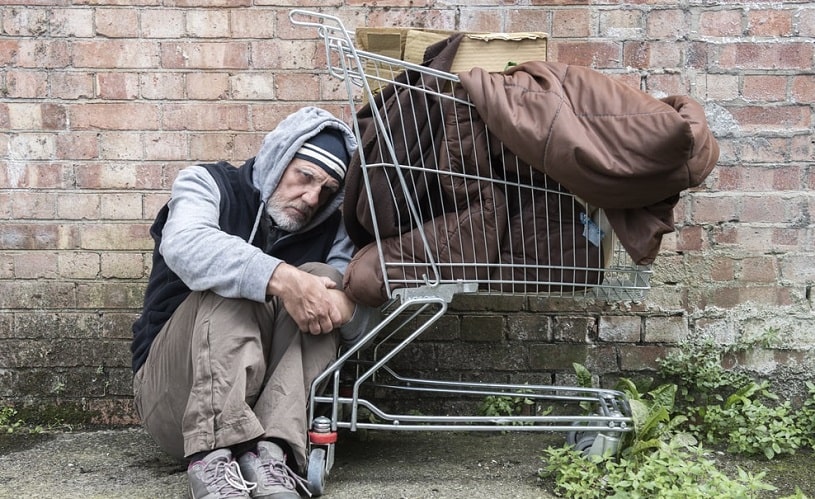Hobo, bum, tramp, vagrant – homeless people are called various names. And a prevalent national stereotype about them is that they are all victims of homeless drug addiction or alcoholism. Experts cannot agree whether addiction leads to homelessness or whether homeless people are at high risk of becoming a homeless drug addict. One thing is clear, however.
Table Of Contents:
- What Is Life On The Streets Like?
- Do All Homeless People Have Mental Health Issues?
- Are All Homeless People Drug Addicts?
- Does Addiction Come Before Or After Homelessness?
- Is There A Link Between Addiction, Unemployment, And Homelessness?
- Where Can A Homeless Person Find Help?
- How Can Homeless Addicts Get Clean?

Addiction and homelessness are both critical national problems that are interlinked. Homeless people with addiction problems and co-occurring mental illness are some of the most vulnerable groups in society.
A 2008 national survey conducted in 25 American cities found that addiction is the biggest reason for becoming homeless in single adults. A 2007 study by Didenko and Pankratz indicated that two-thirds of people living on the streets blamed alcohol or drug use for their homelessness. On the other hand, homelessness and drug abuse are closely related. It is not uncommon for homeless people to abuse alcohol and drugs to cope with the difficulties of life on the street.
It’s like trying to answer the age-old chicken and the egg question. It appears that drugs and alcohol are both the cause and result of homelessness. How big is the problem of addiction among the homeless? What can be done to help substance abusers who are sleeping rough? Read on to learn more.
The Realities of Life on the Streets
For most people, homelessness is a temporary problem. Therefore, the size of the homeless population varies, and the numbers only indicate a snapshot in time. Even the interpretation of the term homeless varies depending on the context. In general, the lack of a fixed, regular, safe, and adequate place to sleep at night is regarded as homelessness.
Homeless People May Find Themselves in Different Types of Sheltered and Unsheltered Circumstances:
- Sleeping out in the open
- Living in abandoned buildings
- Sleeping in a car
- Camping outdoors
- Living in transitional housing or emergency shelters
- Doubling up temporarily with family or friends
Chronic homelessness is defined as being continuous without a home for more than one year or experiencing at least four episodes of rough sleeping in the preceding three years.
According to the US Department of Housing and Urban Development, homelessness affects 18 in every 10,000 people on a national level. Eighteen percent of these people are children.
Homeless people are exposed to a world of problems just because they don’t have a roof over their heads. Every single night, they have to find a safe enough place to stay, which isn’t something they will end up finding. That’s why it is common to see homeless people sleeping in the streets or on park benches. Being out in the open all the time exposes them to problems constantly. That puts them at risk for several health conditions, starting from fundamental nutritional deficiencies, skin diseases all over their bodies, injuries caused by the cold weather conditions. It even puts them at high risk for mental illnesses. All of this is combined with the fact that they barely have access to the same support and love that a person living “normally” in a home would. As a result, they may have to deal with a lot of loneliness, leading to them abusing drugs to distract themselves from the physical pain. It may start a cycle of addiction that isn’t the easiest to break out of when they’re out there, all alone.
Mental Health Issues Among Homeless Population
It is estimated that 25 to 33 percent of homeless individuals have a severe mental illness.
Mental health issues are prevalent in people who have access to a healthy, loving home too, but taking that “safe home” out of the equation means that they may feel like they’re all alone in the world. The relationship between homelessness and mental health disorders is a somewhat complicated one. There’s no one way that the two go together.
There are serious mental illnesses like schizophrenia that are very difficult to deal with even in a “normal life” setting. As a person’s symptoms worsen, they may withdraw from life because it becomes harder and harder to function the way everyone else in society does. They slowly lose the ability to cope with their surroundings, and unless they have the resources, support of their families, and adequate treatment to manage their symptoms, there comes the point where it might get too much to handle, and they end up on the streets. That is a scenario where the mental health disorders that don’t get treatment cause a person to become homeless, but things can just as quickly be the other way around.
According to statistics, there are about 40 thousand homeless veterans in the US. Many veterans suffer from PTSD and other mental health problems caused by trauma. PTSD and addiction come hand in hand. In addition to that, alcoholism in the military is a common problem, as alcohol is readily available for the military personnel. All this explains why veterans can end up on the street and have a substance use disorder at the same time.

Homeless people do not have the same access to resources that could help them with their mental health treatment as everyone else in the normal functioning society would.
If someone is on the streets, not only do they end up at high risk for diseases, but they may also become targets of abuse or sexual assault. Either of which could severely affect someone’s mental health. They may even end up on the streets by running away from abuse.
Research showed that as high as 57% of the female homeless population ended up on the streets while trying to get away from their abusive homes. This is especially the case with alcohol and domestic violence. If their partner abuses alcohol, he is more likely to show signs of aggression and violence. Moreover, victims of domestic violence are also at risk of substance abuse due to the trauma they experienced. Going from a stressful situation to another, which may be even more stressful, may also cause an increased chance of developing severe mental health issues and disorders.
No matter which way things go, it is very easy for a person in a particularly stressed environment to end up seeking an escape with drugs or alcohol. With no real help or resources available for them out in the open, the “escape” might end up being the thing they end up centering their entire lives around. The cycle may be too difficult to break without adequate treatment.
Substance Abuse and Homelessness: A Complex Equation
There is a stereotype about homeless people that many people believe to be true. The stereotype is that every single homeless person is either addicted to drugs or is an alcoholic. That is simply a stereotype. In fact, according to a 2013 survey by The Substance Abuse and Mental Health Services Administration, about 38% of all homeless people had an alcohol dependency, and 26% of the people had a habit of abusing other drugs.
That shows us that even though drug addiction among homeless population is common, not everyone on the streets is a homeless drug addict. And not every substance abuser ends up on the street. So, what are the dynamics between substance abuse and homelessness? Is this co-dependent relationship affected by other factors?
Homelessness and drug abuse can become a way of life when individuals struggle with harsh living conditions, putting them at high risk of turning to alcohol and drugs as a coping mechanism.
A study of homeless youth in Los Angeles found that more than 70 percent had problems with alcohol, drugs, or both.
Teenage alcoholism or drug abuse is a serious problem that can ruin a person’s life before it even starts. Generally, younger people have been recorded to have drug abuse problems, while usually, alcoholism in the elderly homeless people is more common than drug abuse.
People grappling with illicit drug abuse, prescription pill dependence, or alcoholism become entrenched in their addiction. In many cases, the resulting downward spiral of broken relationships and unemployment culminates in homelessness.
The problem is further complicated because, in many homeless people, substance abuse co-occurs with mental illnesses. Untreated mental health disorders can lead to inappropriate self-medication with prescription drugs. In addition, this group of people faces several obstacles in obtaining drug rehab and stable housing.

The main problem here is that it’s simply a lot easier to access drugs and alcohol on the streets than find opportunities to break the cycle and get out of the situation. To gain a stable job, one has to have housing and a permanent address, which is the main thing that a homeless person does not have. That becomes one of the main barriers to even getting the possibility of a stable income. That keeps them in the “hustle” life. They may have to beg or do odd jobs to stay afloat. When that becomes common enough, turning to drugs and alcohol seem like the easier and somehow more stable alternative than trying to gain employment. It pushes a homeless person deeper and deeper into the cycle of substance abuse and homelessness.
A homeless drug addict may frequently cycle between jails, streets, and emergency rooms with a discontinuity in medical care. Unfortunately, not all programs for the homeless accept individuals with substance abuse issues. And not all programs for substance abusers living on the streets are adequate for mental health treatment.
Homelessness and Addiction – What Comes First?
Although substance abuse and homelessness are terms that are often believed to go hand in hand, homelessness and addiction aren’t necessarily things that happen together. There are certain circumstances that lead to people developing an addiction, and also circumstances that lead to homelessness. The answer of “what comes first?” will vary from person to person. But to help differentiate between the two situations, we can split them into two separate sections.
Why Do Homeless People Become Addicts?
Living on the streets is no easy feat, and while many addicts who are on the streets blame addiction for the fact that they ended up on the streets in the first place, drug addiction among homeless people doesn’t always play out that way. Some people become homeless and then develop a drug abuse problem.
A study from 2008 that involved studying homeless people and their addiction showed that 66% of them resorted to drugs and alcohol after they became homeless.
The addiction trap is very easy to fall into. If a person was used to the regular way of life and ended up homeless, their entire world turns upside down. Drugs seem like the perfect escape to get out of the situation at hand and cope with what’s going on. There is also the “human need to belong.” When people lose their home, they lose the one place they could actually belong, and to fit in on the streets, they usually end up trying drugs out. That may also involve peer pressure, but once a person gets into the habit of doing drugs, things can get to a point where their entire day is focused on getting enough money so they can end it with drugs or alcohol. The cycle grows with their addiction, locking them into long-term homelessness.
Why Do Drug Addicts End Up on the Street?
Drugs have a way of totally taking over someone’s life. When a person first tries a drug, they usually don’t go into it thinking they’ll get addicted, but as their use becomes more and more frequent, it becomes challenging to avoid addiction. The person may find themselves slowly working up to addiction, to the point where that becomes their priority. They will end up spending most of their money there, sometimes even if that means missing out on essential things like rent.
That eventually affects their overall credit score. It also can affect employment, lead to domestic violence situations, cause evictions if there is a disruption (smells, loud noises, etc.); this and missed rent can lead to problems securing another home later on. And finally, lead to mental health problems too.
Substance Abuse, Unemployment, and Homelessness: What is the Link?
Substance abuse and homelessness do not discriminate. Men and women of any age can fall prey to various illicit substances. It can trigger a series of events that lead to unemployment and housing loss.
Illicit drug use and prescription pill use that are obtained on the street do not come cheap. Depending on the severity of the addiction, the habit can cost a fortune. It is not unusual for hard-core heroin addicts to feed their habit by spending $200 a day. Many addicts begin spending a substantial portion of their income on drug use, leading to a shortage of money. Very soon, there is a mounting pile of unpaid bills and several months of skipped rent or mortgage payments.

Addiction does not go unnoticed in the workplace. As an addict sinks deeper and deeper into substance use, unfinished work starts to pile up, and performance plummets. This becomes evident to coworkers and bosses. Addicts may also start missing work more often, and sooner or later, the excuses run out, and the employer lets the person go.
The job loss can serve as a wake-up call to get back on track. Or the path of self-destruction can continue with the addict ending up on the streets.
Finding Help: Drug Rehab for the Homeless
Living on the streets is tough. The homeless are exposed to extreme temperatures and nonexistent sanitation. Inadequate clothing, poor nutrition, and lack of clean water take a toll on their health. As a result, chronic diseases are common in this population. For this reason, individuals battling substance abuse and homeless life require several different support services, including specialized healthcare for the homeless.
Yet, there are many challenges to addiction treatment in the homeless. Families may not even be able to find a homeless person. If they do find them, it may take some convincing to get help, especially if the addiction is strong or complicated by mental illness.
If a homeless person wants to look for something stable and easy to access everywhere, SAMHSA programs and resources exist throughout the US. They have access to safe homes, opportunities, rehab facilities to get someone off the streets, and a more regular way of life—one step at a time.
Anthony Foundation (San Francisco, CA)
That is a facility that’s specifically for men that are over the age of 18. They specialize in getting people clean and then also provide them with opportunities to help them earn and rejoin society. Although this facility takes in only a limited number of men at a time, men can even volunteer at the facility and get to stay there for free for the allotted time. Some medical facilities are for free, too, while a couple of them are charged a nominal fee.
Beginning World Changers (Lynn Haven, FL)
The facility has specific programs to help homeless people out of the cycle of homelessness. They provide detox facilities and even help fund the recovery of their IDs and birth certificates. Beginning World Changers is a nonprofit organization, although their programs are paid. They offer 5,6, and 7-day projects throughout the year billed on the 15th of every month.
Recovery Program Solutions of Virginia (Arlington, Annandale Merrifield, Reston, & South County, VA)
This facility only functions in the Northern Virginia area. They have programs and services designed to help take care of adults struggling with mental health disorders, substance abuse, and homelessness. This treatment center runs a variety of programs, and many of them are free of cost. However, long-term housing support may come at a fee.
Chances Transition Home (Los Angeles, CA)
This facility is a transitional home for adults that have been sober for over 30 days. As they leave a medical or rehab facility, the transition home gives them the added stability they may need until they figure out a permanent solution. This facility accepts insurance and private pay for some of their resources, while others, like free daily meals, are offered for free.
Union Rescue Mission (Los Angeles, CA)
This facility helps people dealing with substance abuse and homeless life, regardless of their age, get off the streets by providing them with food, shelter, education, and counseling along with long-term recovery programs. In addition, the facility offers gradual payment plans to make the program more accessible to people that start with no money in hand.
Note: The programs at these facilities may change throughout the year. For accurate information about the financial plans they accept, visit the facility’s website, or contact them via phone call to get one on one information.
Helping the Homeless Addict: What Needs to be Done?
With a little humility and a lot of hope and determination, homeless addicts can set positive goals and change the game. Taking care of their physical health and relying on peer support are important aids to recovery. Training in money management, education and employment opportunities, daily living skills, and rejoining the community are all services that can help make the process successful.
This process isn’t easy, it takes a lot of care, work, and determination, and it isn’t even something that will 100% of the time work the first time a person tries to get clean and off the streets. But, by using the right resources, homeless people can find programs built for their problems and help them get to a functional, healthy life, away from drug use, and with the security of a “real” home—beating both homelessness and addiction at once.
Hope Without Commitment
Find the best treatment options. Call our free and confidential helpline
Most private insurances accepted
Page Sources
- United States Conference of Mayors, United States Conference of Mayors. Task Force on Hunger, & Sodexho (Firm). (2004). A status report on hunger and homelessness in America's cities. United States Conference of Mayors. http://www.ncdsv.org/images/USCM_Hunger-homelessness-Survey-in-America's-Cities_12%202008.pdf
- U.S. Department of Housing and Urban Development. (2020) Annual Homeless Assessment Report. https://www.hud.gov/press/press_releases_media_advisories/hud_no_21_041
- Harvard Medical School. 2014. The Homeless Hentally Ill. https://www.health.harvard.edu/newsletter_article/The_homeless_mentally_ill
- Institute of Medicine (US) Committee on Health Care for Homeless People. Homelessness, Health, and Human Needs. Washington (DC): National Academies Press (US); 1988. 3, Health Problems of Homeless People. Available from: https://www.ncbi.nlm.nih.gov/books/NBK218236/
- Family And Youth Services Bureau. Domestic Violence and Homelessness: Statistics (2016) https://www.acf.hhs.gov/fysb/fact-sheet/domestic-violence-and-homelessness-statistics-2016
- The National Coalition for the Homeless. 2017. Substance Abuse and Homelessness. https://www.va.gov/HOMELESS/nchav/resources/docs/mental-health/substance-abuse/Substance-Abuse-and-Homelessness-508.pdf
- NIDA. (1997, June 1). Drug Abuse Among Runaway and Homeless Youths Calls for Focused Outreach Solutions. Retrieved from https://archives.drugabuse.gov/news-events/nida-notes/1997/06/drug-abuse-among-runaway-homeless-youths-calls-focused-outreach-solutions
- Johnson, G., & Chamberlain, C. (2008). Homelessness and substance abuse: Which comes first?. Australian Social Work, 61(4), 342-356. https://www.tandfonline.com/doi/abs/10.1080/03124070802428191
- Institute of Medicine Staff. (1988). Homelessness, health and human needs. National Academies Press. https://www.ncbi.nlm.nih.gov/books/NBK218235/



